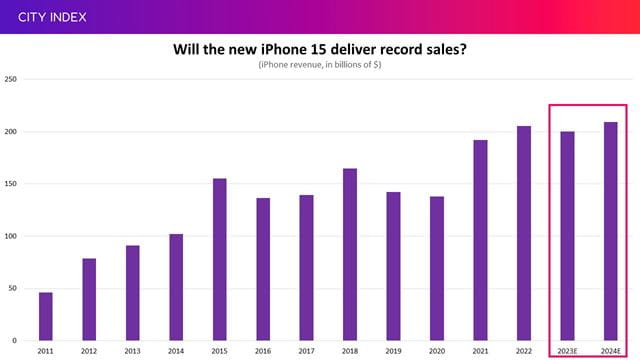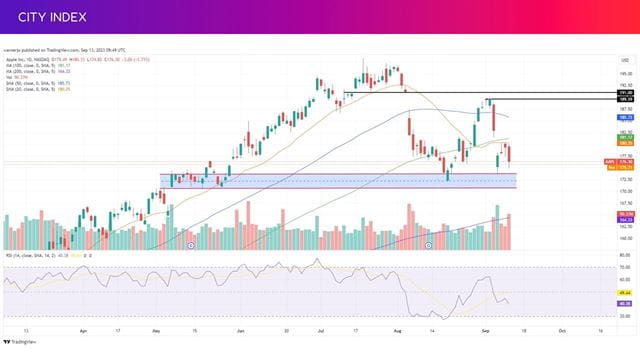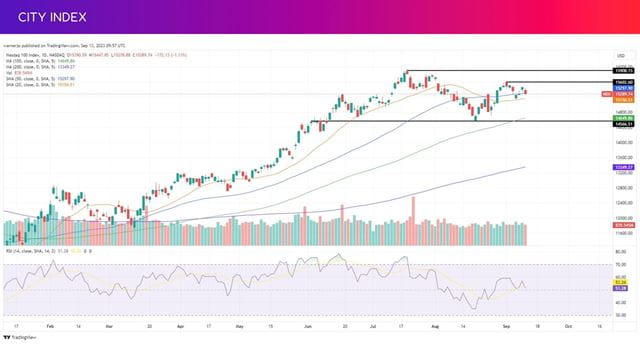
Key takeaways
- Apple has launched the new iPhone 15 with incremental upgrades and the handset will hit the shelves in just over a week.
- The top-end model, the Pro Max, has had its price lifted by $100 and all other prices have held steady
- Chinese government says there is no ban on iPhones in China, but its prospects in the country are still under threat as Huawei gains ground
- We may see some profit-taking after the event, and September has been one of the worst months for the stock in recent years
Apple launches iPhone 15
Apple has unveiled the new iPhone 15 models, packed with incremental upgrades to the frame and materials, the camera and its overall performance, as well a switch to a USB-C charging station following new rules introduced in Europe.
Prices for the entry-level model were kept at $799 and the Pro still costs $999 but the Pro Max, its top-end model, has had its starting price raised by $100 to $1,199.
The industry has found it more and more difficult to deliver game-changing upgrades and Apple has been saving its best developments for its Pro models, which has been enticing more consumers to opt for higher-end handsets. “Our Pro models represent the very best of Apple innovations,” said CEO Tim Cook.
Apple will start to take pre-orders for the iPhone 15 on Friday September 15 and they will begin to be shipped to customers and on the shelves from Friday September 22.
Can the iPhone 15 revive demand?
Apple has proven more resilient than its rivals amid the slowdown in the smartphone market, having gained market share over its rivals, but it has not been immune and annual sales of the iPhone 14 are forecast to be down around 2.5% this year.
The pressure is therefore on the iPhone 15 to revive demand and encourage consumers to upgrade or switch from Android. It is unclear what sort of volumes Apple is aiming for but the challenging environment has led to reports that volumes could be broadly flat compared to the iPhone 14.
Still, iPhone revenue – which accounts for over half of Apple’s total topline income - should get a boost from the lift in price of the Pro Max, although the decision to hold prices of its other models steady, particularly the Pro, may weigh on estimates for the 2024 financial year.

(Source: Company reports, with estimates from Bloomberg)
It is worth noting that while iPhone demand is struggling to grow, it is still bringing more consumers into its ecosystem where it can push its array of higher-margin digital services, such as Apple TV and Music or Apple Pay.
Apple stock: Will the iPhone 15 provide a catalyst?
The launch of the iPhone is the biggest event of the year for Apple, but not one that has historically benefited its share price. In fact, September has been one of the worst periods of the year for Apple stock considering it has lost ground during the month in five of the last six years alone.
Markets did not provide a welcome reception to the event yesterday, with Apple shares closing down 1.7% and losing further ground in early premarket trade today. Apple shares have been under pressure since a broader pullback in tech stocks occurred at the start of August, but the stock is still up over 40% this year and we may have seen some wait for the much-hyped event before cashing-in some profits.
Notably, Apple shares tend to perform better in October as markets ready themselves for its fourth quarter results that tend to come out at the end of the month and sets the stage for demand ahead of the key holiday shopping season that is typically the busiest sales period for its latest iPhone model. Apple shares have gained ground during October in four of the last six years and November and December have, in recent years, seen more gains than losses.
Will threats from China weigh on Apple stock?
Apple shares have also struggled to gain ground around the event because threats in China are growing. The mood ahead of the event was soured by reports that the China is banning government workers from using iPhones at work.
Importantly, a spokesperson from the Chinese foreign ministry said they have noticed the media reports of a ban because of security incidents involving the iPhone, but denied that it has introduced any ban on the device. “China has not issued laws and regulations to the ban the purchase of Apple of foreign brands’ phones”, said spokesperson Mao Ning, according to Bloomberg.
However, markets may worry that while an outright ban isn’t on the table, government workers may still be discouraged from opting for Western-designed phones. It is unsurprising that the Chinese government isn’t pushing for a formal ban considering how important Apple is to its own economy – most of all iPhones sold around the world are made in China and keep hundreds of thousands of workers employed in the country.
That suggests China is more likely to try to find a balance between holding Apple back so home-grown competitors can gain ground without dealing such a blow that it hurts its own economy, which is already struggling since reopening after it abandoned its fight with Covid-19.
China accounts for almost one-fifth of Apple’s iPhone sales and estimates on how big an impact the potential ban in China could have vary from as low as 1% of total iPhone sales in the country to as high as 20%, suggesting there is still a significant level of uncertainty lingering over the issue as geopolitical tensions between the US and China remain high.
There is precedent for this. We saw iPhone sales take a noticeable hit in 2019 and 2020 from the trade war that erupted between the US and China and more protectionist measures were introduced. For now, an outright ban looks unlikely but that won’t stop fears that Apple’s prospects in China are deteriorating…
Apple vs Huawei: Apple’s loss in Huawei’s gain
That is because investors are also worried that Chinese firm Huawei is rapidly gaining ground in the world’s biggest smartphone market because of the ban and a broader push encouraging Chinese citizens to choose domestic brands. Huawei has just launched its new Mate 60 Pro and reports suggest it is flying off the shelves, with news surfacing yesterday (just hours before the Apple event) that it was raising its shipment target for the new phone in the second half by 20% due to strong demand.
Apple grew its market share in China during the second quarter, rising 6.1% from the year before to give it over 15% of the market. It was one of just two major brands that kept growing, but the other was Huawei and it saw its market share rocket to 13% from just over 7% a year earlier. That is making investors nervous that Apple, which is already lagging behind other domestic rivals like OPPO and vivo, could move further down the league table.
|
China smartphone market share |
Q2 2023 |
Q2 2022 |
|
OPPO |
17.7% |
17.7% |
|
vivo |
17.2% |
19.2% |
|
Honor |
16.4% |
19.5% |
|
Apple |
15.3% |
14.1% |
|
Xiaomi |
13.1% |
15.6% |
|
Huawei |
13.0% |
7.3% |
|
Others |
7.3% |
6.8% |
(Source: IDC quarterly mobile phone tracker)
JPMorgan said yesterday that it Huawei has been making a comeback in China and is on course to gain further ground. “This is likely to halt iPhone market share gains in China and could put some downward pressure on iPhone 15 units post product launch this week,” said analyst Gokul Hariharan.
Can India provide new growth?
One major change this year is India. Apple has been shifting more production to the country for two main reasons – to reduce its reliance on manufacturing in China and so it can take advantage of India’s growing middle-class.
For the first time ever, the new iPhone 15 will be launched in India on the same day as other major markets like the US, Europe and the UK. Previously, production ran behind what we saw in China and products were introduced later on, but Apple is now making a bigger push – and drumming-up new growth from India and other emerging markets may prove more critical than ever if demand in China comes under pressure.
Where next for AAPL stock?
Apple shares are currently on course to book their worst monthly performance of 2023 in September following the recent selloff that has wiped hundreds of billions of dollars off its valuation.
Buyers have returned to the market when Apple shares have hit $173.50 over the past month, although we could see it slip to as low as $170.50 before finding support. Sub-$170 would be on the cards if this support range fails to hold.
We can see Apple shares have tried and failed to break above the 50-day moving average this week, with sellers reliably coming in and pushing the stock back down. This is the immediate upside goal for the stock before it looks to climb back toward $190, which proved too irresistible for sellers at the start of this month. From there, it is a short climb to $191.50 to close that gap we saw back in early August.

Nasdaq 100 analysis: Where next?
Apple is the biggest component of the Nasdaq 100, meaning it has a big influence on how the index performs.
The index has been setting lower-lows since rebounding from two-month lows last month. The index slipped below the 20-day moving average yesterday and we are waiting to see where the next low lies, with the previous one currently aligned with the 50-day moving average at 15,150. A move below here would set a new lower-low and could encourage sellers. The immediate floor for the index is that two-month low of 14,600.
The index would need to surpass Monday’s peak of 15,450 and then the September-peak of 15,600 to demonstrate it is back on the right path before eyeing the 2023-high of 15,900.

How to trade Apple stock
You can trade Apple shares and the Nasdaq 100 with City Index in just four easy steps:
- Open a City Index account, or log-in if you’re already a customer.
- Search for the stock or index you want in our award-winning platform
- Choose your position and size, and your stop and limit levels
- Place the trade
Or you can practice trading risk-free by signing up for our Demo Trading Account.











